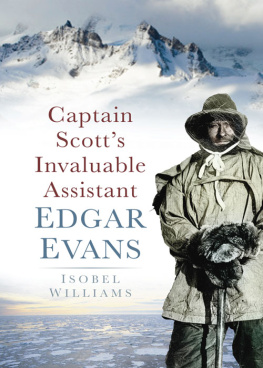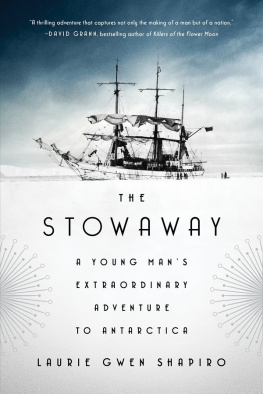Thank you for downloading this Simon & Schuster ebook.
Get a FREE ebook when you join our mailing list. Plus, get updates on new releases, deals, recommended reads, and more from Simon & Schuster. Click below to sign up and see terms and conditions.
CLICK HERE TO SIGN UP
Already a subscriber? Provide your email again so we can register this ebook and send you more of what you like to read. You will continue to receive exclusive offers in your inbox.
We hope you enjoyed reading this Simon & Schuster ebook.
Get a FREE ebook when you join our mailing list. Plus, get updates on new releases, deals, recommended reads, and more from Simon & Schuster. Click below to sign up and see terms and conditions.
CLICK HERE TO SIGN UP
Already a subscriber? Provide your email again so we can register this ebook and send you more of what you like to read. You will continue to receive exclusive offers in your inbox.

Simon & Schuster
1230 Avenue of the Americas
New York, NY 10020
www.SimonandSchuster.com
Copyright 2018 by Laurie Gwen Shapiro
All rights reserved, including the right to reproduce this book or portions thereof in any form whatsoever. For information, address Simon & Schuster Subsidiary Rights Department, 1230 Avenue of the Americas, New York, NY 10020.
First Simon & Schuster hardcover edition January 2018
SIMON & SCHUSTER and colophon are registered trademarks of Simon & Schuster, Inc.
For information about special discounts for bulk purchases, please contact Simon & Schuster Special Sales at 1-866-506-1949 or .
The Simon & Schuster Speakers Bureau can bring authors to your live event. For more information or to book an event, contact the Simon & Schuster Speakers Bureau at 1-866-248-3049 or visit our website at www.simonspeakers.com.
Interior design by Ruth Lee-Mui
Jacket design by Pete Garceau
Jacket photograph from the Ohio State University Archives
Library of Congress Cataloging-in-Publication Data
Names: Shapiro, Laurie Gwen, author.
Title: The stowaway : a young mans extraordinary adventure to Antarctica / Laurie Gwen Shapiro.
Description: First Simon & Schuster hardcover edition. | New York : Simon & Schuster, 2018. | Simon & Schuster nonfiction original hardcoverTitle page verso. | Includes bibliographical references and index.
Identifiers: LCCN 2017007428 (print) | LCCN 2017010926 (ebook) | ISBN 9781476753867 (hardcover : alkaline paper) | ISBN 9781476753881 (Ebook)
Subjects: LCSH: AntarcticaDescription and travel. | Gawronski, Billy, 19101981TravelAntarctica. | StowawaysAntarcticaBiography. | Ocean travelHistory20th century. | Adventure and adventurersAntarcticaBiography. | Teenage boysNew York (State)New
YorkBiography.
Classification: LCC G875.G38 S53 2018 (print) | LCC G875.G38 (ebook) | DDC
919.8904dc23
LC record available at https://lccn.loc.gov/2017007428
ISBN 978-1-4767-5386-7
ISBN 978-1-4767-5388-1 (ebook)
Dedicated to my father
JULIUS SHAPIRO
my hero and lifelong champion.
All that is personal soon rots; it must be packed in ice or salt.
William Butler Yeats
PROLOGUE

W ith his back against the sunset, a seventeen-year-old boy lingered on the docks along the Hudson River. By his calculations, it was a ten-minute swim from where he stood to the ship.
The new high school graduate waited, his soft grey eyes fixed on the City of New York , moored and heavily guarded on the Hoboken piers. The sun went down at six forty-five this dayAugust 24, 1928but still he fought back his adrenaline. He wanted true darkness before carrying out his plan. At noon the next day, the ship would leave New York Harbor and sail nine thousand miles to the frozen continent of Antarctica, the last frontier on Earth left to explore. He intended to be aboard.
That summer, baby-faced Billy Gawronski was three inches short of his eventual height of five foot eleven, and his voice still squeaked. You are a late bloomer, his doting immigrant mother told him in thickly accented English. Yet the ambitious dreamer, born and raised in the gritty tenement streets of the Lower East Side, was as familiar with Commander Richard Evelyn Byrds flagship as any reporter assigned to cover its launch. The Antarctica-bound barquentine was an old-fashioned multi-masted ship that suggested the previous century, with enchanting square sails arranged against an almost impenetrable maze of ropes. The 161-foot wooden vessel spanned half a city block, her 27-foot beam taller than a three-story building. Sail- and steam-powered and weighing 200 tons, with sturdy wooden sides 34 inches thick, she had seen duty as an Arctic icebreaker for Norwegian seal hunters starting in 1885. On one run in icy waters in 1912, her captain had been the last to see the Titanic ; just ten miles away, hed been afraid to help the sinking ship, as he was hunting illegally in territorial waters. Like so many immigrants, the ship once known as Samson found her name changed when she arrived in America in 1928, becoming the City of New York . She was the most romantic of the four boats in Byrds cobbled-together flotilla, and the one leaving firstwith the greatest fanfareearly the next afternoon.
Several times in his mind that evening, Billy dove into the Hudson and started swimming, only to find his feet firmly on land. But he had been on board the SS New York before. Nine days earlier, he and two thousand other New Yorkers had taken the Fourteenth Street Ferry to Hoboken, New Jersey, and gaped at the City of New York , moored next to the grand Dutch ocean liner the SS Veendam . The crowd was wowed with anticipation. Just past noon, the ships captain, Frederick Melvillesecond cousin of the nineteenth-century author Herman Melvillegave the okay, waving the first sweaty guests up the gangway, their dollar admission supporting the Byrd Antarctica expeditions fund-raising drive. Several members of Melvilles crew, including the chief engineer, Thomas Mac Mulroy, and sixty-year-old veteran sailmaker John Jacobson, joined him in greeting the adoring public. No, he told them, Byrd was not aboard. Everyone still wanted to gawk.
When it had been Billys turn to board, hed wandered the wooden decks, still cargo free to accommodate guests. The poop aft (rear deck) was elevated, housing Commander Byrds cabin, an elegant wood-paneled chart room, and a state-of-the-art radio room with technology that would let the explorers be heard no matter how far they sailed. Under the poop deck were spaces for the machine room and the radio generator. One level down were seven cabinsthe cramped quarters where the men would sleepas well as several storerooms, and lockers for holding mops and paint. He stood in the machine room with other touristsmen and women content to admire all the nifty gadgets. Also aft were the ships engine and oppressively hot boiler room.
None of these places had been right for a hiding spot. Forward proved more promising, with its large focsle (forecastle, a front deck), and a second, smaller focsle in the peak: a narrow hollow under the bowsprit (a thick pole projecting from the upper end of a sailing vessel) of the boats prow (the part of the bow above the water). Here, under this second hidden focsle, Billy had spied a good-sized space in a shelf. The exposed top focsle would be visible to anyone on the ship during the departure ceremonies, but the second focsle would remain dark. Satisfied with his investigation, the lad grabbed one of the commemorative paper cups set aside as a souvenir before heading for the ramp.
Next page












